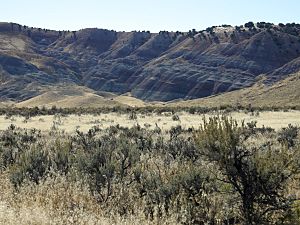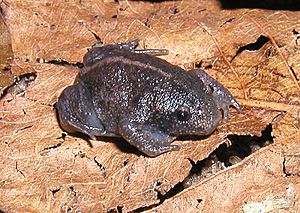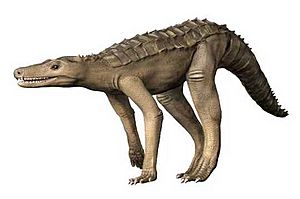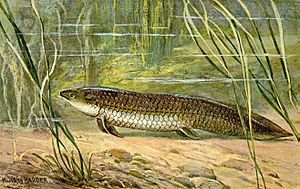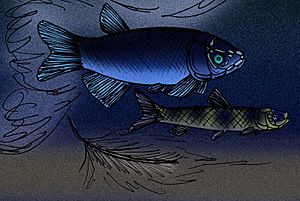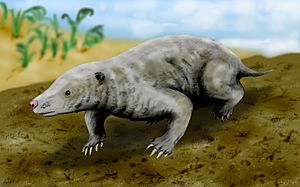Paleobiota of the Morrison Formation facts for kids
The Morrison Formation is a special set of rock layers from the Late Jurassic period. You can find it in the western United States. These rocks are famous for having a huge variety of fossils, especially dinosaur fossils! The formation is made of different kinds of rock like mudstone, sandstone, siltstone, and limestone. These rocks can be light grey, greenish grey, or red. Most of the fossils are found in the green siltstone and lower sandstone layers. These layers were once ancient rivers and floodplains during the Jurassic period.
Contents
- Ancient Animals of the Morrison Formation
- Amphibians: Frogs and Salamanders
- Arthropods: Ancient Insects
- Choristoderes: Reptiles Like Crocodiles
- Crurotarsans: Crocodiles and Their Relatives
- Dinosaurs
- Fish: Life in Ancient Waters
- Lizards and Snakes
- Mammaliaforms: Early Mammals
- Pterosaurs: Flying Reptiles
- Sphenodonts: Tuatara Relatives
- Turtles: Armored Reptiles
Ancient Animals of the Morrison Formation
The Morrison Formation is like a treasure chest of ancient life. Scientists have found fossils of many different creatures here. Let's explore some of the amazing animals that once lived in this area!
Amphibians: Frogs and Salamanders
Fossils of frogs are found in the Morrison Formation, but they are quite rare. Early discoveries led to names like Eobatrachus and Comobatrachus. However, today, scientists only recognize two real frog species from this time: Enneabatrachus hechti and Rhadinosteus parvus.
Scientists have also found parts of unnamed frogs in Colorado, Wyoming, and Utah. The best frog fossils come from Dinosaur National Monument. These ancient frogs were small, with some like Enneabatrachus hechti weighing only a few grams. Rhadinosteus parvus was about 42 millimeters (1.6 inches) long.
Salamander fossils are also present, but they are even rarer than frogs.
Color key
|
Notes Uncertain or tentative taxa are in small text; |
| Name | Species | State | Notes |
|---|---|---|---|
| Enneabatrachus | E. hechti | * Utah
|
A small frog, only a few grams in weight. |
| Iridotriton | I. hechti | An early type of salamander, related to today's advanced salamanders. | |
| Rhadinosteus | R. parvus | * Utah | A small frog, about 42 mm (1.6 inches) long. |
Arthropods: Ancient Insects
Insects are very rare finds in the Morrison Formation. So far, only a few types have been identified. These include ancient social insects that built nests, a type of water bug, and a grasshopper.
Color key
|
Notes Uncertain or tentative taxa are in small text; |
| Name | Species | State | Notes |
|---|---|---|---|
| Morrisonnepa | M. jurassica | * Utah | A type of water bug. |
| Parapleurites | P. morrisonensis | * Colorado | An ancient grasshopper, known from a single forewing. |
Choristoderes: Reptiles Like Crocodiles
Choristoderes were a group of reptiles that looked a bit like crocodiles or lizards. They lived in or near water.
| Name | Species | State | Notes |
|---|---|---|---|
| Cteniogenys | C. antiquus | * Colorado
|
A reptile about 25 to 50 cm (10 to 20 inches) long. |
Crurotarsans: Crocodiles and Their Relatives
Crocodiles were very common in the Morrison Formation. They came in many sizes and lived in different habitats. Some were small, fast-running land crocs, like Hallopus victor and Fruitachampsa callisoni. Others were larger, more typical crocodiles.
Color key
|
Notes Uncertain or tentative taxa are in small text; |
| Name | Species | State | Notes | Images |
|---|---|---|---|---|
| Amphicotylus | A. gilmorei | * Wyoming | ||
| A. lucasii | * Colorado | |||
| A. stovalli | * Oklahoma | |||
| Diplosaurus | D. felix | * Colorado | ||
| Eutretauranosuchus | E. delfsi | * Colorado
|
||
| Fruitachampsa | F. callisoni | * Colorado | A small, running crocodile. | |
| Hallopus | H. victor | * Colorado | Another small, running crocodile. | |
| Hoplosuchus | H. kayi | * Arizona
|
||
| Macelognathus | M. vagans | * Colorado
|
||
| Theriosuchus | T. morrisonensis | * Wyoming | Known from a nearly complete lower jaw. |
Dinosaurs
The Morrison Formation is most famous for its incredible dinosaurs! Many well-known dinosaurs like Allosaurus, Stegosaurus, and Brontosaurus lived here.
Fish: Life in Ancient Waters
Even though the Morrison climate was often dry, there were enough rivers and lakes to support many kinds of fish. Fish fossils are common in some areas, especially in Wyoming. Most of these ancient fish are very different from fish alive today.
One interesting fish was Hulettia, a small fish about 7.6 cm (3 inches) long. It probably lived in calm waters and had thick, interlocking scales. Another fish, Morrolepis, had eyes set far forward on its head. It could grow to about 20 cm (8 inches) long.
Some fish, like Ceratodus, were lungfish. These fish could breathe air and grow quite large, up to 2 meters (6.5 feet) long. They likely ate small invertebrates, similar to modern lungfish.
Color key
|
Notes Uncertain or tentative taxa are in small text; |
| Name | Species | State | Notes | Images |
|---|---|---|---|---|
| Ceratodus | C. fossanovum | A lungfish that could grow up to 2 meters long. It probably ate small invertebrates. | ||
| C. ?frazieri | ||||
| C. robustus | ||||
| Indeterminate. | Known from tooth plates. | |||
| Hulettia | H. hawesi | * Colorado | A small fish, about 7.6 cm (3 inches) long, with thick scales. | |
| cf. Leptolepis | N/A | * Colorado | A 13 cm (5 inch) fish, more advanced than other Morrison fish. It likely ate other fish and small invertebrates. | |
| Morrolepis | M. schaefferi | * Colorado | A fish with forward-set eyes, growing up to 20 cm (8 inches) long. | |
| Potamoceratodus | P. guentheri | * Colorado | Once thought to be a type of Ceratodus. |
Lizards and Snakes
The Morrison Formation has also given us clues about ancient lizards and snakes.
| Name | Species | State | Notes |
|---|---|---|---|
| Diablophis | D. gilmorei | * Colorado | An early type of snake. |
| Dorsetisaurus | * Wyoming | A lizard related to modern monitor lizards and Gila monsters. | |
| Paramacellodus | * Colorado
|
A small lizard with blunt teeth. | |
| Saurillodon | Indeterminate | * Colorado | A lizard also found in other Jurassic sites around the world. |
| Schillerosaurus | S. utahensis | * Utah | A small lizard found only in the Morrison Formation. |
Mammaliaforms: Early Mammals
Many types of early mammals lived in the Morrison Formation. Most were small, but they had many different lifestyles. Some were like rodents, some were meat-eaters, and one even looked like an anteater!
In 2009, a study looked at the size of these ancient mammals. It found that Docodon was the largest, weighing about 141 grams (5 ounces). The smallest was Fruitafossor at only 6 grams (0.2 ounces). Most Morrison mammals were quite small.
Tinodontids
These were early mammals.
| Name | Species | State | Notes |
|---|---|---|---|
| Eurylambia | E. aequicrurius | * Wyoming | An early mammal similar to Tinodon. |
| Tinodon | T. bellus | * Wyoming | Early mammals called Tinodontids. |
| T. lepidus | * Wyoming |
Eutriconodonts
Eutriconodonts were a group of early mammals, often with three-cusped teeth. Some were meat-eaters.
| Name | Species | State | Notes |
|---|---|---|---|
| Amphidon | A. superstes | * Wyoming | A small early mammal. |
| Aploconodon | A. comoensis | * Wyoming | An early mammal. |
| Comodon | C. gidleyi | * Wyoming | An early mammal, slightly larger than Aploconodon. |
| Triconolestes | T. curvicuspis | * Utah | An early mammal that might have been able to glide or fly. |
| Trioracodon | T. bisulcus | * Wyoming | An early mammal similar to Priacodon. |
Multituberculates
Multituberculates were a very common type of early mammal. They had special teeth that looked like they were good for grinding plants.
| Name | Species | State | Notes |
|---|---|---|---|
| Ctenacodon | C. laticeps | * Wyoming | |
| C. scindens | |||
| C. serratus | * Wyoming | ||
| Glirodon | G. grandis | * Colorado
|
|
| Morrisonodon | M. brentbaatar | * Wyoming | |
| Priacodon | P. ferox | * Wyoming | |
| P. fruitaensis | * Colorado | ||
| P. grandaevus | * Wyoming | ||
| P. lulli | * Wyoming | ||
| P. robustus | * Wyoming | ||
| Psalodon | P. fortis | ||
| P. marshi | |||
| P. potens | |||
| Zofiabaatar | Z. pulcher | * Wyoming |
Other Mammals
| Name | Species | State | Notes |
|---|---|---|---|
| Docodon | D. victor | The most massive early mammal found in the Morrison Formation. | |
| Fruitafossor | F. windscheffeli | * Colorado |
A small early mammal that might have dug for food, similar to an anteater. |
Dryolestoids
Dryolestoids were another group of early mammals.
| Name | Species | State | Notes |
|---|---|---|---|
| Amblotherium | A. gracilis | * Colorado | A small early mammal. |
| A. megistodon | * Wyoming | ||
| Araeodon | A. intermissus | * Utah
|
An early mammal, smaller than Paurodon. |
| Archaeotrigon | A. brevimaxillus | * Wyoming | Early mammals similar to Paurodon. |
| A. distagmus | |||
| Comotherium | C. richi | * Wyoming | An early mammal. |
| Dryolestes | D. obtusus | Common early mammals. | |
| D. priscus | * Wyoming | ||
| D. tenax | |||
| Euthlastus | E. cordiformis | * Wyoming | An early mammal. |
| Foxraptor | F. atrox | * Wyoming | An early mammal similar in size to Paurodon. |
| Laolestes | L. eminens | Common early mammals. | |
| L. grandis | |||
| Miccylotyrans | M. minimus | * Morrison | An early mammal. |
| Paurodon | P. valens | * Wyoming | An early mammal. |
| Pelicopsis | P. dubius | * Wyoming | An early mammal. |
| Tathiodon | T. agilis | * Wyoming | An early mammal. |
Pterosaurs: Flying Reptiles
Pterosaurs were flying reptiles, but their fossils are very rare in the Morrison Formation. This is because their bones were thin and fragile, so they didn't preserve well. Even so, scientists have found their remains in many different places.
These ancient flyers probably ate fish, insects, or even scavenged on dinosaur carcasses. They were quite diverse, from small insect-eaters like Mesadactylus to larger hunters like Harpactognathus, which had a wingspan of about 2.5 meters (8 feet).
Color key
|
Notes Uncertain or tentative taxa are in small text; |
| Name | Species | State | Notes |
|---|---|---|---|
| Harpactognathus | H. gentryii | * Wyoming | A large pterosaur with a wingspan of about 2.5 meters (8 feet). |
| Kepodactylus | K. insperatus | * Colorado | A large pterosaur with a 2.5 meter (8 foot) wingspan. |
| Mesadactylus | M. ornithosphyos | * Colorado | A smaller pterosaur, likely an insect-eater. |
Sphenodonts: Tuatara Relatives
Sphenodonts are a group of reptiles that are related to modern Tuataras, which live in New Zealand.
| Name | Species | State | Notes |
|---|---|---|---|
| Eilenodon | E. robustus | * Colorado | A relatively large sphenodont. |
| Opisthias | O. rarus | * Colorado
|
A sphenodont similar to the modern Tuatara. |
| Theretairus | T. antiquus | * Wyoming | A small sphenodont. |
Turtles: Armored Reptiles
Turtles are very common fossils in the Morrison Formation. This is because their hard, bony shells preserved very well over millions of years.
The most common turtles were Glyptops plicatus and Dinochelys whitei. Other types found include Dorsetochelys buzzops and Uluops uluops.
Color key
|
Notes Uncertain or tentative taxa are in small text; |
| Name | Species | State | Notes |
|---|---|---|---|
| Dinochelys | D. whitei | * Colorado
|
A common turtle in the Morrison Formation. |
| Dorsetochelys | D. buzzops | ||
| Glyptops | G. plicatulus | * Colorado
|
A very common turtle fossil. |
| Uluops | U. uluops | * Wyoming |


